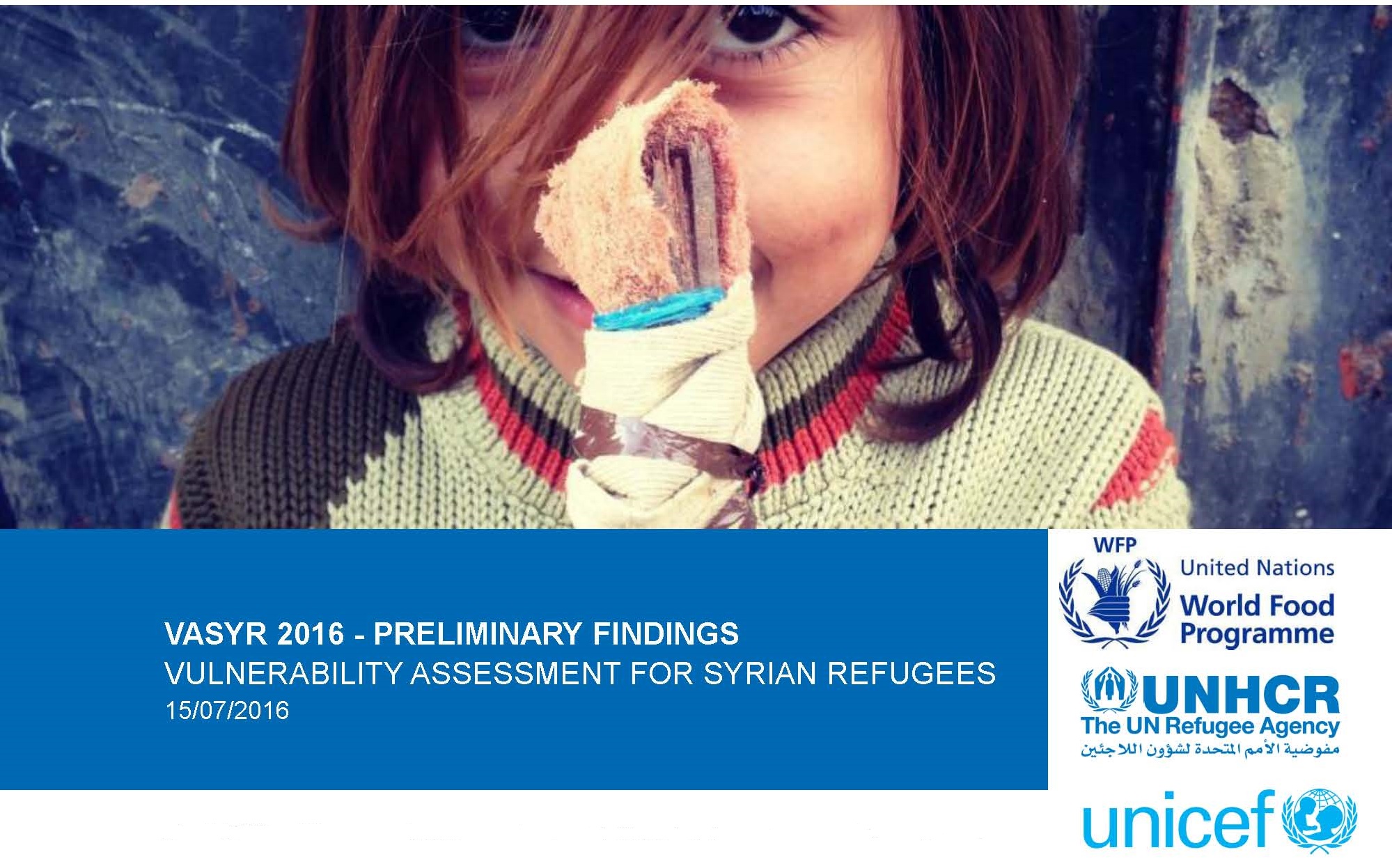Syrian Refugees in Lebanon Remain Vulnerable to Shocks and Reliant on Aid, UN Agencies Say
Annual Assessment Shows over 70 per cent of Syrian Refugees Live below Poverty Line amid Worrying Trend in Food Intake and Quality of Nutrition; ‘Oxygen’ of External Aid has Prevented a Worse Deterioration
BEIRUT: The slide into deeper poverty for Syrian refugees in Lebanon is continuing although, as a result of additional aid, the deterioration has not been as sharp as last year, according to preliminary findings from a 2016 survey by lead UN agencies, which showed that the population remains highly vulnerable to external shocks and reliant on humanitarian assistance to survive.
The initial results from the annual survey released Monday showed that 70.5 per cent of Syrian refugees in Lebanon continue to live below the poverty line. There was a rise compared to 2015 in the number of refugee families living under the so-called Survival Minimum Expenditure Basket (SMEB), a measure of items deemed essential for a household’s survival.
“The economic plight of Syrian refugees did not deteriorate as severely as last year, but we know that this is due to the oxygen of external help. The situation would be even more dire without the aid received to date,” said UNHCR’s Representative in Lebanon, Mireille Girard. “Syrian refugees in Lebanon are still caught in a debt trap, while remaining highly reliant on humanitarian assistance.”
The survey, known as Vulnerability Assessment of Syrian Refugees (VASyR), is conducted annually in Lebanon by the World Food Programme (WFP), the UN Refugee Agency (UNHCR) and the United Nations Children’s Fund (UNICEF).
So far in 2016, USD 979.3 million has been injected into the country under the joint Government-UN led Lebanon Crisis Response Plan (LCRP), which has helped prevent more people from falling below the poverty line. Nonetheless, the survey showed that families have exhausted their limited resources and are having to adapt to surviving on the bare minimum.
The study’s key findings indicate worrying trends concerning food intake and the quality of nutrition consumed due to dwindling resources, with 34 per cent of refugee households found to be moderately food insecure, compared to 23 per cent a year earlier. There was an 11 per cent increase in the number of households that reduced their food expenditure and a 7 per cent increase in those purchasing food on credit.
“The VASyR highlights that food security remains precarious. While the changes from 2015 are not significantly worse, they do confirm that refugees are living on the edge and had suffered assistance cuts last year,” said WFP’s Representative, Dominik Heinrich. “However, thanks to generous contributions from governments this year, WFP is able to continue to provide food security, some stability and hope to up to 700,000 refugees with monthly food assistance.”
An estimated 4.6 per cent of children were assessed as underweight, against 2.6 per cent in 2013, the last time a similar comparison was made. More girls were found to be underweight than boys. All this will have further negative long-term consequences on youth, education and the health of the community at large, unless a sustainable solution is found.
“The findings are a reminder to all of us that a significant share of Syrian households in Lebanon are doing all they can with limited means to keep their children healthy and safe,” said UNICEF’s Representative, Tanya Chapuisat. “For those who have lived through the violence in Syria and endure hardship in the host country, health care, food, emotional support and education are simply vital. An entire generation depends on our ability to protect the most vulnerable of the vulnerable – that is what we should be judged by, how successful we are in reaching those most in need.”
For housing, the report showed that 54 per cent of Syrian refugees are need of continuous support to upgrade shelters to meet minimum standards. In addition, 41 per cent are in fragile and insecure accommodation, including makeshift tents in informal settlements (17 per cent) and other types of substandard shelter (24 per cent), which might include garages, sheds, industrial sites and unfinished buildings. It also showed 22 per cent face overcrowding and a lack of privacy, up from 18 per cent. Some experience tenure concerns and are at risk of eviction and other threats
There are currently 1.03 million Syrian registered refugees in Lebanon. The survey was based on information from 4,950 households, 72 percent of whom received direct financial assistance. The findings are subject to change; a full report will be released in the fall.
The most vulnerable refugee families continue to receive desperately needed humanitarian support from the UN and NGO partners, but sustainable, continued support is needed to ensure that nobody falls through the cracks. The humanitarian community requires additional funding to continue providing life-saving food, shelter, health and education assistance through the end of the year.
For further information contact:
UNHCR
- Matthew Saltmarsh, Senior Communications Officer, +41 79 217 3140, [email protected]
- Lisa Abou Khaled, Assistant Communications/Public Information Officer, +961 71 880 070, [email protected]
- Dana Sleiman, Public Information Officer, +961 71 910 626, [email protected]
WFP
- Abeer Etefa, Senior Communications Officer, WFP/Cairo, [email protected], +2010 66634352
- Dina El-Kassaby, Communications Officer, WFP/Cairo, [email protected], +2010 15218882
- Edward Johnson, WFP/Beirut, [email protected], +961 76320761
UNICEF
- Soha Boustani, Chief Communication, +961 3 236 167, [email protected]
- Salam Abdulmunem, Emergency Communication Officer, +961 7 996 605, [email protected]
شارك على الفيسبوك شارك على تويتر

